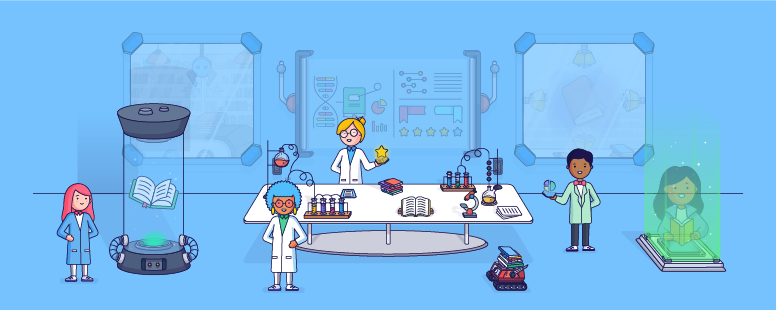Building Literacy-Rich Environments
Christophe Spy/ February 17, 2022/ 21-22 SY, Literacy in K-12, Teacher Tips/ 0 comments
Building Literacy-Rich Environments
In classrooms every day, teacher-designed instruction immerses students in acts of literacy: reading, writing, speaking, and listening. Across all content areas, educators engage their learners in literacy practices with the purpose of refining these skills so that the students are able to appropriately express themselves and hold meaningful exchanges with others.
While it’s a practice in all classrooms, meaningful literacy instruction should strive to be accessible, engaging, and enriching to all learners.
- Accessibility means meeting the learners where they are.
- Engaging means instilling interest in the content.
- Enriching means broadening the scope of the curriculum.
To ensure that curriculum is considerate of these necessary qualities, teachers should create and maintain literacy-rich environments.
How to Foster a Positive Relationship With Literacy
Literacy-rich environments focus on students being actively and meaningfully engaged in reading, writing, speaking, and listening with consideration of both digital and written formats. To create a space that fosters a positive relationship with literacy, teachers should be mindful of the following aspects of their classrooms:
- Design
- Instruction
- Materials
Building Literacy-Rich Environments With Intentional Design
The design of instructional spaces can greatly impact teaching and learning. When setting up or reimagining the classroom space, teachers should ensure that there are areas intentionally dedicated to literacy practices. Purposeful placement of books, print items, digital resources, and writing materials highlight their importance within an educational setting.
Reinforce the Value of Reading
Having a classroom library acts as a physical reminder of the value teachers place on reading. A classroom collection of books reinforces independent reading in a student-friendly way.
Allowing students to conveniently and freely browse titles makes perusing for reading content more approachable. A smaller sample of texts than what’s offered at the school library or local public library can make exploration less overwhelming.
Teachers can manage their classroom libraries so that they dedicate valued space for high-interest books within a variety of genres. Selecting titles that connect to content that is currently being covered allows for students to have opportunities to further explore the subject matter to enhance their understanding.
Integrate the Old With the New
The beauty of today’s classrooms is that they aren’t limited as spaces of either this or that, but they instead work to accommodate everyone. Literacy-rich environments strive to be representative of all students in their design, which means holding space for digital tools as well.
Dedicate a place to plug-in to ensure that electronic devices such as tablets or laptops are charged and ready when it’s time to use them. Visual representations such as charts and posters with device rules, steps for access, and quick guides allow the students to independently and appropriately work within digital spaces.
Within the classroom set-up, there should be ample opportunity for students to positively interact with a variety of digital tools, physical texts, and writing materials that support literacy learning. Intentional classroom design will allow for designated spaces in which the students are able to use these resources to learn on their own as well as with others.
Building Literacy-Rich Environments With Instruction
Proper instructional techniques play a major part in creating literacy-rich environments. Building literacy should be the right blend of independent and teacher-led practice. Doing so will result in higher rates of student achievement and academic growth.
Meaningful and Engaging Experiences are Purpose-Driven
Teacher-led practice can help model what students should strive to do independently. To make classroom instruction engaging, set a purpose for reading and interacting with texts in a variety of ways.
Before reading, engage in one of these strategies that help the students think about the text:
- Activating prior knowledge
- Analyzing visuals, sections, and titles
- Building background knowledge
- Introducing key vocabulary terms
- Making predictions from text features
While reading, talk and write about the text in real time with close reading strategies such as:
- Annotating effectively with hands-on techniques
- Citing evidence to support answers
- Clarifying unfamiliar information
- Driving discussion with student-led questions
- Making meaningful connections
After reading, take time to reflect about the text in verbal and written formats. Revisit the content and make further connections in subsequent order to build upon the theme over the course of the unit.
Learning tasks that have genuine application help students to understand the function and use of literacy in everyday life. Students will find more relevancy and value in their work as a result. Purposeful literacy activities promote meaningful and engaging experiences for students, ones that they will remember beyond the classroom.
Building Literacy-Rich Environment with Materials
The right materials in the classroom motivate students to read and write. They create opportunities to share ideas, hold dialogue, and engage with others as partners in literacy.
Materials must be intentionally selected to highlight a variety of genres, purposes, and text types with consideration of the students’ interests, needs, and skills. However, reading materials don’t need to be limited to worksheets, textbooks, and paperback and hardcover books.
Offering texts in a variety of formats supports all kinds of learners. While physical books and pen on paper are a top choice for some, learning spaces are continually being integrated with technology that encourages digital literacy.
Read about how reading digitally is more important than ever.
Leverage Digital Literacy
Tapping into e-reading platforms allows students to explore a variety of texts and can also create an opportunity for multiple students to interact with the same text. Portability of digital texts means that students are able to access them wherever they are–at school, at home, for instruction, in their free time–on a smartphone, tablet, or computer.
Additionally, digital platforms can be more supportive of all types of learners in their accessibility to read and/or listen to the texts. Glose for Education is a digital-reading platform that supports learners through personalization features and inclusive tools. By providing individualized support and creating an interactive environment, e-reading experiences become more enriching for students.
Teachers, in turn, benefit from being able to gather meaningful and relevant data from Glose for Education’s extensive dashboard. With this information, teachers are better able to meet their students where they are to increase comprehension and build reading rigor.
All Students Deserve Supportive Learning Environments
Literacy is tied to all classrooms. Teachers should strive to establish literacy-rich environments organized for learning through accessible classroom design, engaging instruction, and enriching materials.
What are some ways you have made your classroom literacy-rich? Comment below.
About the Author: Katie Witte is a secondary English educator of 10+ years who has worked with students ranging from 5th to 12th grade. Within her current role with Fort Wayne Community Schools, she serves her district as a lead teacher, assessment writer, curriculum collaborator, program manager, and quality improvement team member. Most of her experience has been working with learners within a nontraditional school setting at the Allen County Juvenile Center. Her inclusive instruction is designed with social-emotional consideration to support her students with positive outcomes in their academic achievement and personal growth. As a dedicated lifelong learner, she has a BS in Business Marketing, a BS in Education, and a MA for Teachers in English all from Indiana University Fort Wayne. |

